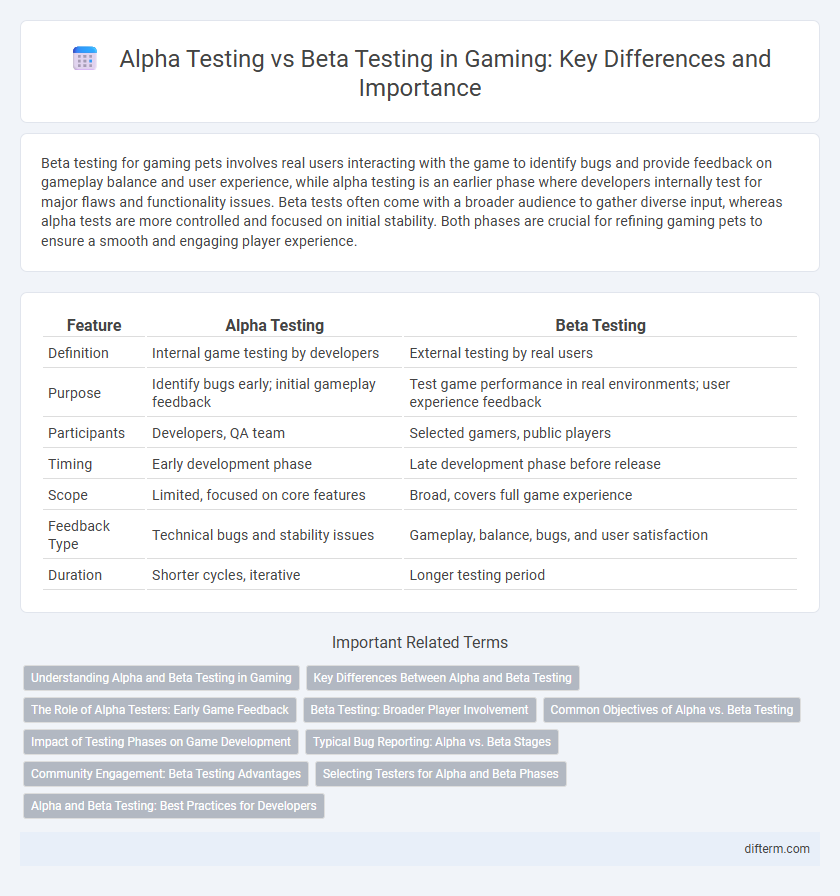Beta testing for gaming pets involves real users interacting with the game to identify bugs and provide feedback on gameplay balance and user experience, while alpha testing is an earlier phase where developers internally test for major flaws and functionality issues. Beta tests often come with a broader audience to gather diverse input, whereas alpha tests are more controlled and focused on initial stability. Both phases are crucial for refining gaming pets to ensure a smooth and engaging player experience.
Table of Comparison
| Feature | Alpha Testing | Beta Testing |
|---|---|---|
| Definition | Internal game testing by developers | External testing by real users |
| Purpose | Identify bugs early; initial gameplay feedback | Test game performance in real environments; user experience feedback |
| Participants | Developers, QA team | Selected gamers, public players |
| Timing | Early development phase | Late development phase before release |
| Scope | Limited, focused on core features | Broad, covers full game experience |
| Feedback Type | Technical bugs and stability issues | Gameplay, balance, bugs, and user satisfaction |
| Duration | Shorter cycles, iterative | Longer testing period |
Understanding Alpha and Beta Testing in Gaming
Alpha testing in gaming focuses on uncovering critical bugs and gameplay issues within an internal environment, often involving developers and selected testers to refine core mechanics. Beta testing extends this process by releasing a near-complete version to a broader audience, collecting user feedback on performance, balance, and user experience across diverse hardware setups. Both phases are essential for ensuring game stability, optimizing player engagement, and preparing the game for a successful launch.
Key Differences Between Alpha and Beta Testing
Alpha testing, conducted internally by developers and quality assurance teams, focuses on identifying major bugs and usability issues during early game development, often in a controlled environment. Beta testing involves a broader external audience, such as selected gamers or the public, to evaluate real-world performance, gameplay experience, and gather feedback on game balance and stability. Key differences include the testing stage, target testers, and objectives--alpha testing aims for foundational improvements, while beta testing validates the game's readiness for launch.
The Role of Alpha Testers: Early Game Feedback
Alpha testers play a crucial role in the gaming development process by providing early feedback on core gameplay mechanics, graphics, and stability during initial development stages. Their insights help identify major bugs and design flaws before the game reaches a broader audience, enabling developers to refine features and improve user experience. This early testing phase significantly reduces risks and sets the foundation for successful beta testing cycles.
Beta Testing: Broader Player Involvement
Beta testing in gaming involves a broader player base compared to alpha testing, allowing developers to gather diverse feedback from real-world users. This phase helps identify gameplay issues, bugs, and balance problems across different hardware and playstyles. The extensive player involvement during beta testing ensures a more polished and stable final release.
Common Objectives of Alpha vs. Beta Testing
Alpha testing focuses on identifying critical bugs and gameplay issues within a controlled environment, enabling developers to refine core mechanics and ensure stability before public exposure. Beta testing evaluates overall user experience, performance, and compatibility on diverse hardware configurations, gathering real-world feedback to optimize balance and address remaining glitches. Both phases aim to improve game quality, but alpha targets early-stage functionality while beta emphasizes polish and user satisfaction.
Impact of Testing Phases on Game Development
Alpha testing uncovers critical bugs and gameplay issues early, allowing developers to refine core mechanics and improve stability before public exposure. Beta testing gathers broader user feedback on performance, balance, and user experience, revealing real-world challenges across diverse hardware and network conditions. These testing phases collectively enhance game quality, reduce post-launch patches, and increase player satisfaction, thereby directly influencing successful game development cycles.
Typical Bug Reporting: Alpha vs. Beta Stages
Alpha testing typically involves internal testers who identify and report critical bugs related to core gameplay mechanics, performance issues, and major crashes before the game is accessible to the public. Beta testing engages a broader audience, often including real players, to reveal usability problems, minor glitches, and compatibility issues across various hardware configurations. Detailed bug reports from beta testers provide valuable feedback on user experience, balancing, and network stability, significantly influencing final game polish.
Community Engagement: Beta Testing Advantages
Beta testing enhances community engagement by involving a broader group of players outside the development team, providing valuable feedback on gameplay balance, bugs, and user experience. This phase fosters a sense of ownership and loyalty among testers, as they contribute to refining the game before official release. Active community participation during beta testing also helps identify diverse hardware issues and player behaviors, ensuring more robust and inclusive game performance.
Selecting Testers for Alpha and Beta Phases
Selecting testers for alpha testing typically involves a small group of internal developers and highly trusted users who provide detailed feedback on core functionalities and initial gameplay mechanics. Beta testing opens participation to a broader audience, often including early adopters and community members who help identify bugs, balance issues, and usability concerns in more diverse real-world scenarios. Careful selection based on experience, platform diversity, and engagement level ensures valuable insights throughout both phases.
Alpha and Beta Testing: Best Practices for Developers
Alpha testing involves internal evaluation by developers and testers to identify critical bugs and gameplay issues before public exposure, ensuring early-stage quality control. Beta testing extends this process to a broader audience, gathering diverse user feedback on game performance, balance, and usability to refine the final product. Implementing structured feedback mechanisms and clear testing objectives during both phases maximizes efficiency and enhances game stability and player experience.
beta testing vs alpha testing Infographic

 difterm.com
difterm.com